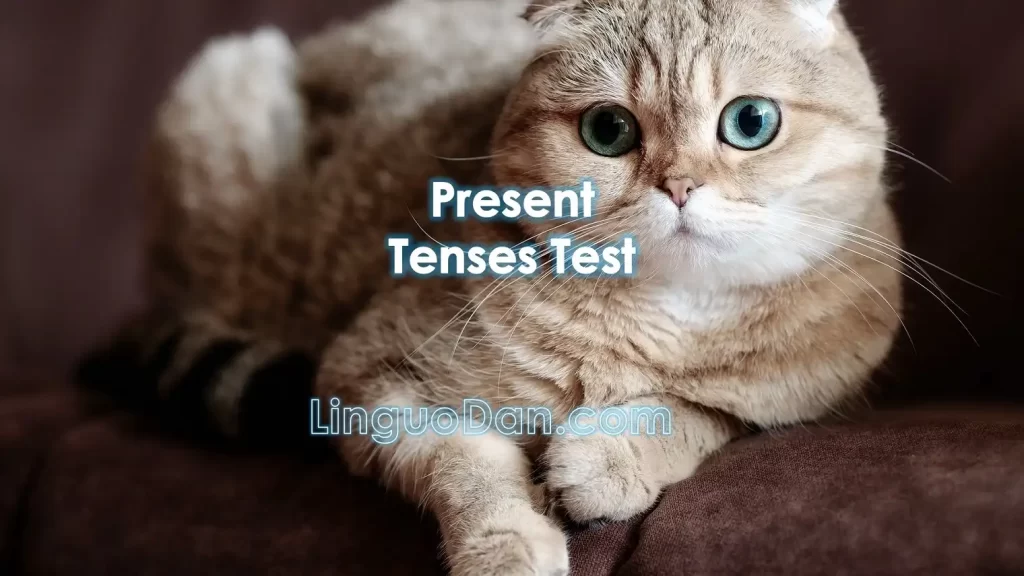Rules and examples of the present tense in English

The Present Tense: A Practical Guide with 20 Test Questions
The present tense is a fundamental aspect of English grammar. It allows us to express actions, habits, and states of being that occur in the current moment, as well as those that are habitual or timeless. To become proficient in English, a solid grasp of present tenses is essential.
Let’s go over each of the Present Tenses (Present Simple, Present Continuous, Present Perfect, Present Perfect Continuous) in detail.
Present Simple (Present Indefinite)
- Formation:
- Positive sentences: Subject + base form of the verb (add “-s” or “-es” for third person singular).
- Example: She works at a bank.
- Negative sentences: Subject + do not (don’t) / does not (doesn’t) + base form of the verb.
- Example: They don’t like coffee.
- Questions: Do / Does + subject + base form of the verb?
- Example: Do you speak English?
- Positive sentences: Subject + base form of the verb (add “-s” or “-es” for third person singular).
- Usage:
- Used for routine actions, facts, general truths, schedules, and programs.
- Example: She goes to work at 8 AM every day.
- Used for routine actions, facts, general truths, schedules, and programs.
Present Continuous (Present Progressive)
- Formation:
- Positive sentences: Subject + am/is/are + base form of the verb + -ing.
- Example: They are watching a movie.
- Negative sentences: Subject + am not (I’m not) / is not (isn’t) / are not (aren’t) + base form of the verb + -ing.
- Example: She isn’t studying right now.
- Questions: Am / Is / Are + subject + base form of the verb + -ing?
- Example: Are you listening to music?
- Positive sentences: Subject + am/is/are + base form of the verb + -ing.
- Usage:
- Describes actions happening at the moment of speaking or planned for the future.
- Example: I am reading a book at the moment.
- Describes actions happening at the moment of speaking or planned for the future.
Present Perfect
- Formation:
- Positive sentences: Subject + have/has + past participle form of the verb.
- Example: She has visited Paris.
- Negative sentences: Subject + have not (haven’t) / has not (hasn’t) + past participle form of the verb.
- Example: They haven’t eaten lunch yet.
- Questions: Have / Has + subject + past participle form of the verb?
- Example: Have you ever been to Japan?
- Positive sentences: Subject + have/has + past participle form of the verb.
- Usage:
- Used for actions or states that happened in the past but have a connection to the present moment.
- Example: I have lived in this city for five years.
- Used for actions or states that happened in the past but have a connection to the present moment.
Present Perfect Continuous
- Formation:
- Positive sentences: Subject + have/has been + base form of the verb + -ing.
- Example: They have been working on this project for hours.
- Negative sentences: Subject + have/has not been + base form of the verb + -ing.
- Example: She hasn’t been studying all day.
- Questions: Have / Has + subject + been + base form of the verb + -ing?
- Example: Have you been waiting long?
- Positive sentences: Subject + have/has been + base form of the verb + -ing.
- Usage:
- Describes ongoing actions that started in the past and continue up to the present moment.
- Example: They have been playing football since morning.
- Describes ongoing actions that started in the past and continue up to the present moment.
Present Tenses Test
In this guide, we’ll delve into the nuances of the present tense, from the simple Present Simple to the dynamic Present Perfect Continuous. In addition, we offer a set of 20 test questions designed to strengthen your understanding and application of these tenses.